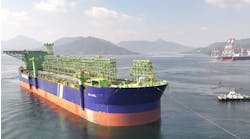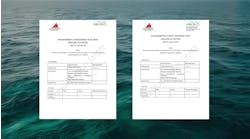Frank Hartley; Drilling/Production Editor
This year’s MWD/LWD Services Directory provides an updated and expanded worldwide directory of services in the global measurement-while-drilling (MWD) and logging-while-drilling (LWD) market.
Click here to view the Survey in pdf.
For quick and easy referencing, the directory is divided into measurement groups, and then sub-divided further by company, and service line. While there are exceptions to every “rule,” the following guidelines limit the number of exceptions for this year’s directory:
• Independent measurement subs, or short tool joints, are listed as a single entry within their respective measurement categories. If the sub can be used with an associated telemetry, or other tools, it is listed again in the respective measurement group.
• Tools with multiple measurement capability are listed in each applicable measurement group
• Independent measurement sub lengths are listed so the reader can combine desired components as needed
• Only directional tools capable of greater than one-axis surveys were considered for the directory
•Tool manufacturers were not included in this year’s directory. Only companies providing services in the measurement-while-drilling and/or logging-while-drilling market were included.
The following abbreviations are used in the directory:
AAPI - Apparent API Accel. - Accelerometer
API - American Petroleum Institute Azi. - Azimuth
DLS - Dogleg severity EM - Gravitation tool face
HF - High flow Incl. - Inclination
LF - Low flow Mag. - Magnetometer
MagF - Magnetic field mpa - Magapascals
MTF - Magnetic tool face N/A - Not applicable
NBI - Near bit inclination OD - Outside diameter
Op. Sel. - Operator selectable Opt. - Optional
RT - Rotary tool Std. - Standard
TBD - To be determined TF - Tool face
TGF - Total gravitational field TMF - Total magnetic field
New tools and technology
A number of new tools and technology have been introduced within the last two years. Some of the more recent developments:
Baker Hughes Inteq
Inteq says that it has combined two LWD subs with multiple real-time formation evaluation measurements for analysis of complex geological data. The Advantage Porosity Logging Suite Elite tool includes formation density, neutron porosity, photoelectric factor, ultrasonic standoff, and an azimuthally focus density measurements and imaging, the company says. The subs are designed to gather data in high-rate of penetration and rotary closed-loop system drilling applications.
Other new tools developed are:
• The OnTrak sensor sub -- integrates five sensors into one compact device and establishes the platform for all of the formation evaluation components in future bottom hole assemblies
• The Acoustic Properties eXplorer (APX) LWD sub - provides real-time, wireline-quality acoustic logging data for accurate reservoir evaluation
• The TesTrak tool -- equipped with an intelligent control system based on the FRA algorithms that control the drawdown pump
• The StarTrak tool, currently being released - a high-resolution electrical imaging tool for geological description applications including thin bed analysis and real-time well placement.
Halliburton/ Sperry Drilling Services
According to Sperry Drilling Services, two new GeoTap tool collar sizes: 4 3/4-in. and 9 1/2-in., have enhanced their LWD formation pressure testing tool box. The smaller tool is uses a single 32 cc drawdown chamber.
Additionally, an 8-in. EWR-M5 propagation resistivity sensor (part of the integrated resistivity, gamma ray, annular pressure, and drillstring vibration package) now includes the same measurements as the 6 3/4-in. tool, plus an annular temperature measurement capability, the company says.
Noble Technology Services Division
Noble Technology has developed a 3D rotary steerable drilling tool for advanced directional drilling technology. The company says the Well Director provides directional drilling control, increased rates of penetration, and a smoother, less tortuous well bore. With MWD built in to the non-rotating housing, the tool’s near-bit sensors make continuous adjustments in the azimuth and inclination to steer the well to the set targets, Noble says.
Additionally, the company says that it developed a second generation rotary steerable with MWD sensors built in to the non-rotating housing. A mud driven turbine generator that has fewer mechanical parts powers the ExpressDrill tool, starting with the 4 3/4-in. design for 6 6 3/4-in. hole sizes.
PathFinder Energy Services
A new platform of MLWD tools has been designed and developed, PathFinder says. The Survivor Suite tool incorporates HPHT directional sensor and formation evaluation logging tools. These tools can operate in flow rates up to 2,000 gal/min, pressures of 25,000 psi, and temperatures of 175° C. This tool includes the Slimhole Density/Neutron Standoff Caliper (SDNSC) tool, the dual frequency Array Wave Resistivity (AWR) tool, the Dynamic Pressure Module (DPM), and the high-pressure/high temperature directional and gamma ray tool that can be run in four different configurations.
Other tools recently developed are:
• The 3D Rotary Steering system features a versatile point-the-bit and push-the-bit design option
•The Drilling Formation Tester is a drilling tool that uses a dual inflatable packer arrangement to measure and transmit formation pressure information while drilling
•The e-sonic tool is a dual frequency LWD sonic tool that includes slow shear analysis
• Proprietary software that include advanced resistivity analysis, invasion profiling, thin bed analysis, shear porosity, natural fracture identification, payzone steering, and pore pressure analysis.
Precision Energy Services
According to Precision, the Hostile Environment Logging MWD (HEL MWD) system is a new MWD system specifically designed for high-pressure/high-temperature and drilling operations at temperatures up to 180° C and pressures up to 30,000 psi. The HEL system operated effectively above its operational limit at a world record of 184° C in a recent well in south Texas.
The company explained that it incorporated the HEL system is incorporated with the PrecisionLWD system along with the multi-frequency resistivity sensor, the thermal neutron porosity sensor, and the azimuthal density sensor. Also, a new addition is the spectral azimuthal gamma ray sensor, which provides wireline-quality spectral data in the LWD environment. All sensors in the system operate at pressures up to 30,000 psi and flow rates up to 1,800 gal/min depending on hole size.
Schlumberger
According to Schlumberger, a new-generation Scope while-drilling services that improves drilling performance and well placement has been developed,. This system quadrupled the data transmission rate over the industry standard.
The family of Scope tools is:
• The PeriScope 15 production enhancement technology is a proactive geosteering tool for directional or horizontal drilling that generates a 360°image and detects resistivity boundaries such as cap rock and fluid contacts up to 15 ft from the wellbore
• The EcoScope multifunctional LWD has a pulsed neutron generator plus drilling and formation evaluation sensors incorporated into one 26-ft collar to provide a comprehensive measurement suite
•The StethoScope formation pressure-while-drilling tool provides formation pressure measurements that improves the efficiency and reduces the risk of drilling
• The TeleScope high-speed telemetry-while-drilling system, when used with the Orion telemetry platform, increases data transmission rates fourfold.
Weatherford
Weatherford explained that its new TrendSet modular MWD system incorporates both electromagnetic (EWave) and mud-pulse (DuraPulse) telemetry to transmit and store in memory pressure-while-drilling (PWD), directional steering, gamma ray, and dual-spaced propagation wave resistivity (DSPR) data.
Other tools recently developed are:
•A new EWave electromagnetic transmitter (gap sub) serves as a wireless telemetry system, transmitting directional and formation evaluation data uphole in either an over- or underbalanced drilling application
•A new DuraPulse tool, completely field interchangeable with the EWave transmitter, offers positive-pulse, rotary-vane, and mud-pulse telemetry for balanced or overbalanced MWD applications.
•A new probe-based dual-spaced propagation wave resistivity (DSPR) tool introduces an entirely new concept in systems design packaging and reliable downhole performance.•
Footnotes explanation for following survey
PathFinder:
(a) HDSM, CWRG, DNSC, CLSS, DPM, DFT, AWR tools are data-linked and may be configured in any order
(b) 2DRS is a stand-alone tool or run with any M/LWD system
(c ) PathMaker is a stand-alone tool or run with any M/LWD system
Unidrill Energy Co. Ltd.:
(d) Sentinel Shock and Vibration Measurement available for all Orienteer and Liberator tools
(e) TRIM resistivity
(f) 4 3/4, 6 3/4, 8, and 9 1/2 in. Orienteer strings retrievable only when run with positive pulse transmission system. Negative pulse system non-retrievable
(g) Pressure drop over +ve pulse Orienteer tools same as Liberator
(h) Provisional
(i) Orienteer steering tool option for 4 3/4, 6 3/4, 8, and 9 1/2 in. tools
(j) Higher temperature rating available on request.
Baker Hughes INTEQ:
(k) Dependent on mud weight, hydraulics, data transmission, and turbine selection
(l) All directional accuracies are to 2 Sigma confidence
(m) All tool combinations require a directional tool (D, AutoTrak, or NaviTrak) as a basic component ex. (D+CCN+ORD+MPR = 69.4
(n) All generic and environment specifications are included in the directional category
(o) Basic AutoTrak configuration consists of near bit inclination + gamma ray + multiple propagation resistivity + vibration + directional sensor + modular connection
(p) Basic Navigator configuration consists of near bit inclination + gamma ray + multiple propagation resistivity + modular connection
(q) Static and dynamic WOB, TOB, bending moment, annular and bore pressure, string RPM, lateral, and axial acceleration. Also includes motor RPM and downhole drilling dysfunction diagnostics
(r) Max DLS values are a function of various parameters such as BHA configuration, well profile, hole size, drilling mode (build, drop, and turn). For optimum tool capabilities and limits, expert company advise is required (BHASYSPro analysis), therefore please contact your local BHI representative for a DLS calculation based on your specific BHA.
Schlumberger:
(s) Accelerometers for vibration and inclination at bit, strain gages for weight and torque, transducer for annular pressure
(t) Down hole Neutron and Gamma Ray sources are wireline retrievable
(*) Variable transmission rates available as an option with Telemetry Systems
(*) Pressure drops are dependent on mud weight and tool configurations
(*) Rotating and sliding Max DLS limitations listed are for infinite connection life
(*) Real time update period are variable depending on tool string configurations.
Halliburton/ Sperry Drilling Services:
(u) The attributes of the pulser sub, negative or positive, and the central interface module sub are not included in any of the data listed for the individual measurement subs
(v) Length for EMT directional tool includes associated subs required for service
(w) Values for EBS are for standard collars; flexed collars are also used and their values are higher for the same nominal tool OD
(x) Special tool designs are rated for higher operating temperatures and pressures (HP: 22,500 psi or 25,000 psi). When using the negative pulsing system, there is no flow rate range; however, a maximum, tolerable mass flow rate is dictated by erosion concerns, and this limit varies by tool size and design
(y) The pressure drop stated for 8-in. tools is for those having a 1.92-in. ID. Some 8-in. tools have an optional larger ID (called 8-in. HF), which will reduce the pressure drop stated and also increase the maximum, tolerable mass flow rate
(z) The pressure drop across the negative pulsing valve is the parameter of concern. This parameter is a function of the mudflow rate, the BHA, and the mud properties.




